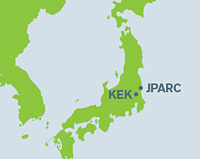 |
Disaster brings physics family closer
A day after the devastating March 11 earthquake and tsunami in Japan, with strong aftershocks still testing surviving buildings, Japanese residents and physicists were offering beds, food, and rides to stranded foreign physicists.
This hospitality in the face of what has been called Japan's worst disaster since World War II was a lifeline for the 30 mostly American and European foreigners at the Japan Proton Accelerator Research Complex, J-PARC.
“The Japanese are the people who helped the foreigners, not the other way around,” said Stony Brook University physicist Chang Kee Jung, international co-spokesman for the T2K experiment in Japan.
While a 10-foot tsunami caused no damage to the laboratory, the magnitude-9 quake took out electricity, water, network phone lines, and part of the dormitory housing. Residents of Tokai, facing a water shortage and damaged buildings and roads, shared what meals they had with the physicists, and offered them shelter in a community center.
Two days later, their Japanese colleagues from KEK, the High Energy Accelerator Research Organization in Tsukuba, were making their way on side roads to pick up the foreigners for evacuation to KEK at Tsukuba, and eventually to Narita Airport. The approximately 59-mile drive took seven hours because the quake had made main roads impassable.
Japanese researchers at the KamLAND neutrino experiment at Kamioka made a similar journey to the hard-hit coastal town of Sendai to take food and water to colleagues at Tohoku University there, said Stuart Freedman, co-spokesman for KamLAND.
Jung, an American physicist who has done research in Japan for 20 years, followed the progress of the aid and evacuation of the foreigners from New York, receiving updates via cell phones and eventually a single Kindle electronic-book reader, which draws less power, until the last battery ran out. Like other physicists across the globe, he wished the best for his Japanese colleagues and their families as their stories slowly emerged through tidbits on social media and newscasts.
Jung said he wasn't surprised at all by the selfless behavior of the Japanese, or by this demonstration that the global particle physics community is, indeed, a family.
“They were just doing what comes naturally,” he said.
To help Japan make a rapid recovery, US researchers continue looking for ways to combine efforts with colleagues in Japan who face personal hardships, repairs to their experiments, and power shortages, potentially for a long time to come.
Tona Kunz
Click here to download the pdf version of this article.






